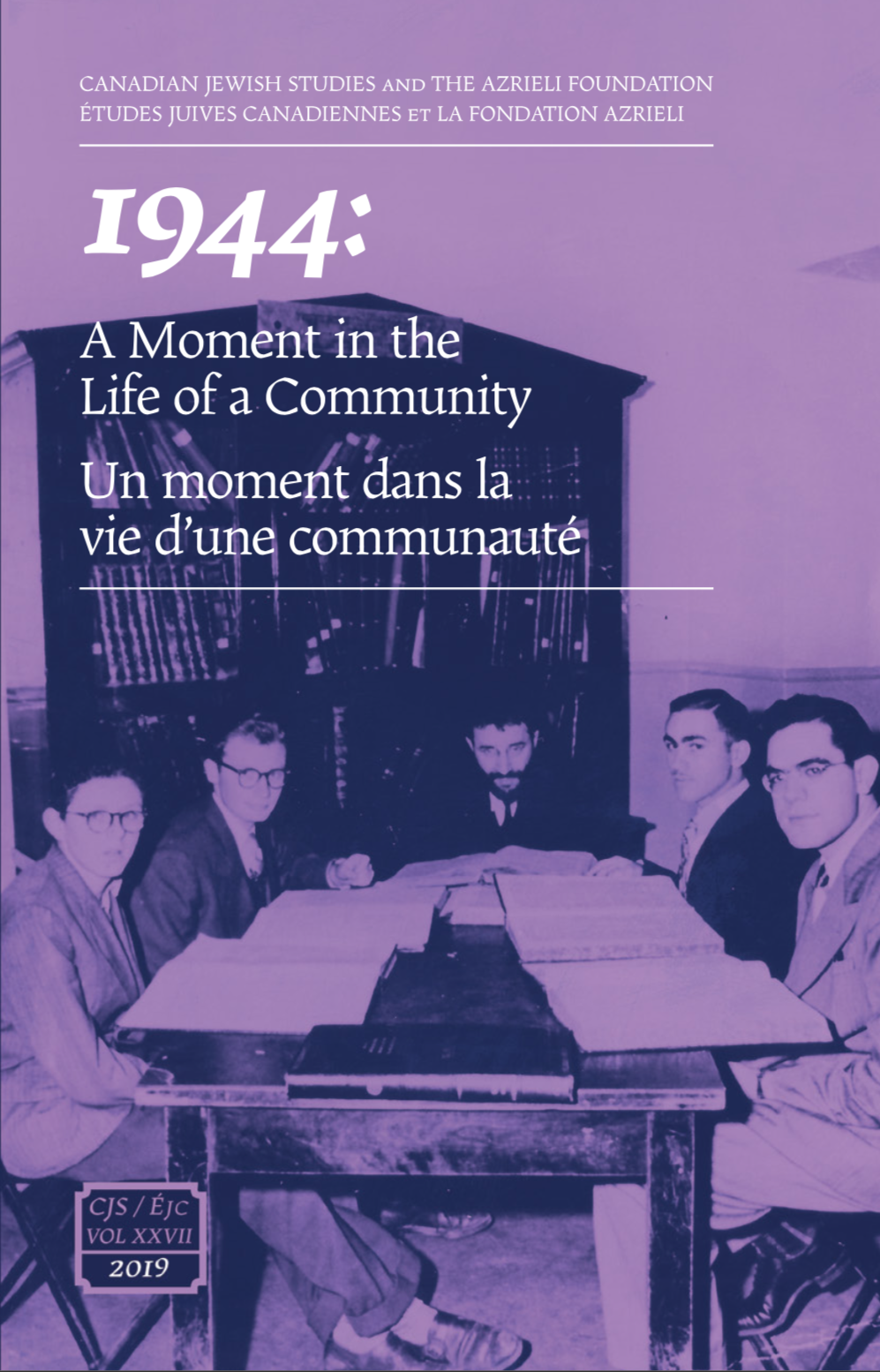1944: What Was Known? What Was Reported? What Was Done? What Could Have Been Done?
DOI:
https://doi.org/10.25071/1916-0925.40105Abstract
It is appropriate, thirty-six years after the publication of None Is Too Many, to reconsider 1944 from the perspective of Canadian Jewry. As Canadians, they were swept up in the war effort, at home and in combat. As Jews, they were frantic about the destruction of Jewish life. In consideration of the questions raised in the title of this paper, we present, somewhat in contrast to Abella and Troper, the following assessment. First, the organized Jewish community, in the context of Canadian ethno-cultural minorities, had a voice. Second that information about the Holocaust, while often inaccurate, was widely published, especially in the Yiddish press. Third, that despite Canada’s complete abdication of political will in providing opportunities for Jews to flee Europe and find a refuge in Canada, the reality of the war, the absence of historical precedent, and the impossibility of foreseeing the calamity, ensured that a comprehensive plan of meaningful rescue could not have been attempted, let alone considered.References
A thorough survey is Israel Gutman, ed., Encyclopedia of the Holocaust four volumes (London: MacMillan, 1990).
Adara Goldberg, Holocaust Survivors in Canada: Exclusion, Inclusion, Transformation, 1947-1955 (Winnipeg: University of Manitoba Press, 2015).
Alan Davies, ed., Antisemitism in Canada: History and Interpretation, (Waterloo: Wilfred Laurier University Press, 1992).
Angus McLaren, Our Own Master Race: Eugenics in Canada, 1885-1945 (Toronto: McClelland and Stewart, 1990). DOI: https://doi.org/10.3138/9781442623316
Auschwitz Protocols, in Guttman (ed.), Encyclopedia of the Holocaust, Volume One, 121-2.
Bialystok, Delayed Impact, 26-27 and 50-56, and James Walker, “Claiming Equality for Canadian Jews: The Struggle for Inclusion, 1930-1945,” in Klein, ed., Nazi Germany, Canadian Responses,218-260.
Chalk and Jonassohn: Armenians in Turkey, pp. 433-4; Hereros, p. 438.
David Goutor, “The Canadian Media and the ‘Discovery’ of the Holocaust, 1944-1945,” Canadian Jewish Studies IV-V (1996-1997): 86-115. DOI: https://doi.org/10.25071/1916-0925.19813
Doris Bergen, War and Genocide: A Concise History of the Holocaust (Lanham, MD: Rowman and Littlefield, 2003).
E. Thomas Wood and Stanislaw M. Jankowski, Karski: How One Man Tried to Stop the Holocaust(London: Wiley, 1994).
Elie Wiesel Night (New York: Bantam Books, 1982), 1-5.
Franklin Bialystok, Delayed Impact: The Holocaust and the Canadian Jewish Community (Montreal and Kingston McGill-Queen’s University Press, 2000).
Gerald Tulchinsky “Jews at War,” in Branching Out: The Transformation of the Canadian Jewish Community (Toronto: Stoddart, 1998).
Horst Drechler, “The Herero Uprising,” and Richard G. Hovannisian, “The Historical Dimensions of the Armenian Question, 1878-1923,” in The History and Sociology of Genocide: Analyses and Case Studies, Frank Chalk and Kurt Jonassohn, eds. (New Haven and London: Yale University Press, 1990), 231-265.
Ira Robinson, A History of Anti-Semitism in Canada (Waterloo: Wilfred Laurier University Press, 2015).
Irving Abella and Harold Troper, None Is Too Many: Canada and the Jews of Europe, 1933-1948 (Toronto: Lester and Orpen Dennys, 1982), 283.
Irving Abella and Harold Troper, “The Line Must Be Drawn Somewhere: Canada and Jewish Refugees 1933-9,” Canadian Historical Review 60, no.2 (1979): 178-209. DOI: https://doi.org/10.3138/CHR-060-02-04
Janine Stingl, Social Discredit: Antisemitism, Social Credit, and the Jewish Response (Montreal and Kingston: McGill-Queen’s University Press, 2000).
Justin Comartin, “Opening Closed Doors: Revisiting the Canadian Immigration Record (1933-1945),” Canadian Jewish Studies XXIV (2016): 77-102.
Lisa-Rose Betcherman, The Swastika and the Maple Leaf: Fascist Movements in Canada in the Thirties, (Toronto: Fitzhenry and Whiteside, 1975).
Max Beer, What Could Have Been Done? The Montreal Jewish Community, the Canadian Jewish Congress, the Jewish Press, and the Holocaust, MA thesis, Concordia University, 2006.
Morton Weinfeld, “The Changing Dimensions of Contemporary Canadian Anti-Semitism,” in D. Penslar, M. Marrus, and J. Gross Stein, eds., Contemporary Antisemitism: Canada and the World (Toronto: University of Toronto Press, 2005). DOI: https://doi.org/10.3138/9781442673342-005
N. Hillmer, B. Kordan, L. Luciuk,eds., On Guard For Thee: War, Ethnicity and the Canadian State, 1939-1945 (Ottawa: Canadian Government Publishing Centre, 1988).
Norman Erwin, “The Holocaust, Canadian Jews, and Canada’s ‘Good War” Against Nazism,” 103-124.
Ormond McKague, ed., Racism in Canada (Saskatoon: Fi!h House, 1991).
Rebecca Margolis, “A Review of the Yiddish Media: Responses of the Jewish Immigrant Community of Canada,” and Amanda Grzyb, “From Kristallnacht to the MS St. Louis Tragedy: Canadian Press Coverage on Nazi Persecution of the Jews and the Jewish Refugee Crisis, September, 1938 to August 1939,” in Ruth Klein, ed., Nazi Germany, Canadian Responses, 78-143.
Rebecca Margolis, “The Keneder Adler and Yiddish community life in Montreal, 1944” Canadian Jewish Studies XXVII (2018). DOI: https://doi.org/10.25071/1916-0925.40107
Richard Menkis, “Anti-Semitism from New France to 1950,” in R. Klein and F. Dimant, eds., From Immigration to Integration: The Canadian Jewish Experience(Toronto: Malcolm Lester, 2001).
Robin W. Winks, The Blacks in Canada: A History(2nd edition) (Montreal and Kingston : McGill-Queen’s University Press, 1997).
Ruth Klein, ed., Nazi Germany, Canadian Response: Confronting Anti-Semitism in the Shadow of War (Montreal and Kingston: McGill-Queen’s University Press, 2012).
Ulrich Frisse, “The Bystanders Perspective: The Toronto Daily Star and its coverage of the Jews in the Holocaust in Canada,” in Yad Vashem Studies 39, vol.1 (2000): 213-43.
“Historians reject claim Allies could have saved Jews,” Canadian Jewish News, 4 May 2017, 27.
“Karski” in Gutman, ed., Encyclopedia of the Holocaust, 1990.
Downloads
Published
How to Cite
Issue
Section
License
Canadian Jewish Studies/ Études juives canadiennes is a journal dedicated to the open exchange of information; therefore the author agrees that the work published in the journal be made available to the public under a Creative Commons Attribution-Noncommercial-No Derivative Works 4.0 Unported License. The publisher (Association for Canadian Jewish Studies / Association d'études juives canadiennes) recognizes the author's intellectual property rights; authors retain copyright over their work. The author grants the publisher first serial publication rights and the non-exclusive right to mount, preserve, and distribute the intellectual property. The journal is digitized and published on the open access website http://pi.library.yorku.ca/ojs/index.php/cjs/index.







